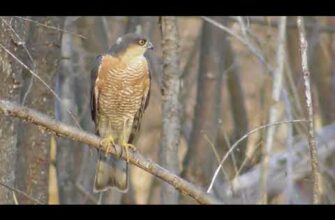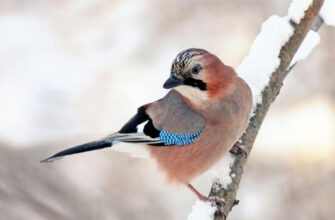The raven is a bird covered with many legends and tales. His image is very often found in the folklore of various peoples of the world. In some tales, he appeared as a mystical harbinger of trouble, in others he is a wise adviser. In whatever form he appears before us, awe and respect for this bird always slip through. What do we know about the crow?
The origin of the species and description
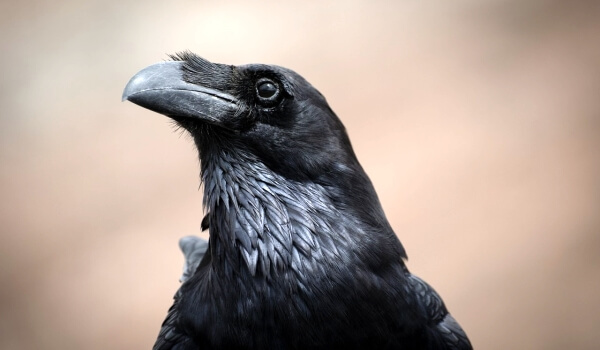
Photo: Raven
The raven is the largest member of the corvid family. This family is one of the representatives of the numerous order Passeriformes. The voice of the raven is loud and sharp, with a characteristic vibration. In addition to the well-recognized croaking and croaking, the bird can make separate, rather complex sounds and even imitate other voices. The origin of the name raven has its origins in the word crow, which means black. There are many legends associated with the acquisition of a raven of such a gloomy color.
Raven, no doubt — one of the oldest creatures on earth. It is difficult to find another such bird, which would be dedicated to such a number of legends and mystical traditions as a crow. He was worshiped and feared by American Indians, harsh Scandinavians, African tribes and peoples of the north. There are multiple references to the raven in ancient manuscripts.
So the cuneiform, dated to the 3rd century BC, tells of a wanderer who escaped on a ship during the universal flood. According to legend, he released a raven, a dove and a swallow from his ship so that they could find land and food. Of all the birds, only the raven managed to find land. Raven Wits — a long-known and indisputable fact.
Appearance and features
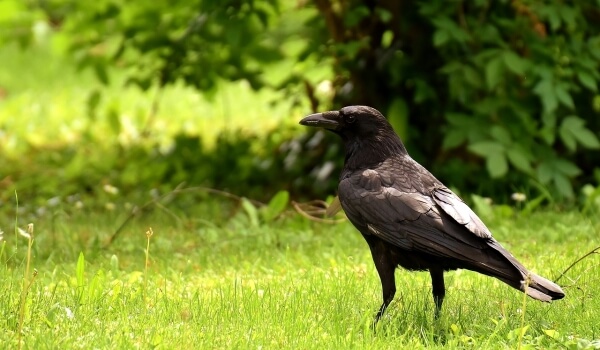
Photo: Raven Bird
The raven is a bird that everyone has seen and heard. But not everyone will be able to distinguish a real raven from relatives close to him. Those who are often mistaken for a crow actually turn out to be a rook or a crow. It is not at all difficult to distinguish a real raven, just look closely. The raven is a large bird, the body length can reach 70 cm. The wing length is up to 47 cm. In a state of wingspan, the wings can reach up to 140 cm. Females are somewhat smaller than males, but apart from size, external signs are practically indistinguishable. The beak is sharp, massive and very large.
Video: Raven
Another distinctive feature of the raven is pointed, ruffled feathers on the throat in the form of a “beard”, which is especially pronounced during the “singing” of the bird. An adult raven has a completely black color, with a bluish tint. The wings of the raven are long and narrowed, the tail is wedge-shaped. The claws of the bird are powerful, sharp, completely black. The bird in flight can also be distinguished, the flapping of the wings is rarer than that of other closely related representatives. The way a raven flies is admirable, it can soar in the sky like an eagle for a long time.
The life expectancy of ravens in nature is up to 15 years. In captivity, where there is a complete absence of external enemies and stable nutrition, the duration increases to 40-50 years.
An interesting fact: In London, on the territory of the Tower Castle, ravens are in the official service of His Royal Majesty, where they are under the strictest protection.
Where does the raven live?
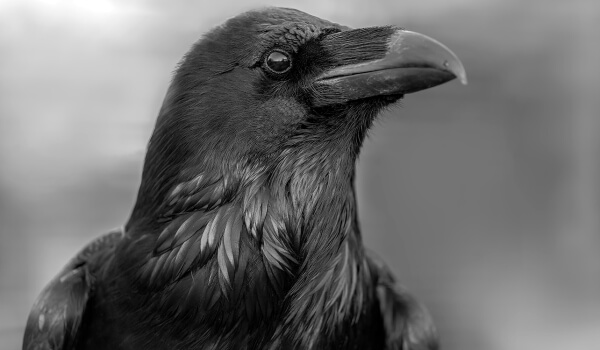
Photo: Black Raven
Due to its unpretentiousness to food and climate, the crow can be found anywhere. It can be the Arctic coast and even the tundra. On the northern ridge, it is more common on rocky seashores and in vegetated river valleys. In the middle lane, it prefers wooded areas with broad-leaved or coniferous forests. Edges with open areas near water bodies and swampy places. Crows try to avoid continuous taiga massifs. Closer to the southern latitudes, the bird settles more readily in hilly areas, does not bypass island and floodplain forests in the middle of the steppes.
If earlier it was believed that the raven avoids proximity to humans, then since the middle of the last century there has been a steady tendency for the bird to move closer and closer to human habitation. In the northwestern territory of Russia, birds began to actively build nests in the suburbs. Including such a large metropolis as St. Petersburg, where they have not been met before. The raven began to pay much less attention to the person, although he was always careful with him. It is not uncommon to nest on multi-storey buildings in large cities.
Most often, the raven moves closer to the person with the onset of winter. Due to the high snow cover and the decrease in the number of active animals, it becomes more difficult to get food in nature. In the city, the crow can often be found in the places where the dumpsters are located.
What does the crow eat?
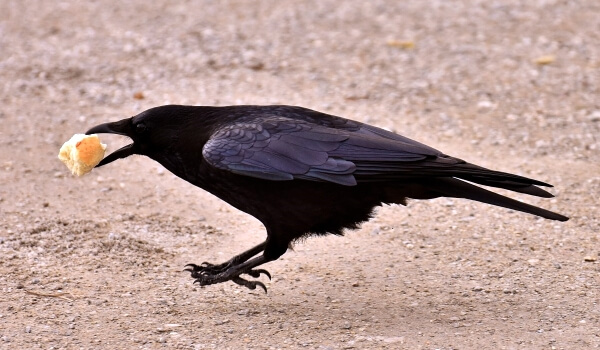
Photo: Raven bird
The raven is an omnivorous bird, it is often called the orderly of nature, and so it is. The crow is also called a scavenger. Yes, a bird eats dead animals with pleasure, but at the same time only fresh meat, a rotten animal is unlikely to interest it. It is not averse to hunting for any small game itself, while it can hang for a long time, hovering in the air. The vision of a raven is quite sharp and, having chosen a victim, it rushes at it like a falcon.
The prey of a raven in the wild is usually:
- lizards;
- frogs;
- snakes;
- rodents;
- chickens of other birds;
- large beetles and larvae.
Gets from him and poultry, for this he is very disliked by the villagers. If a raven finds someone else’s clutch with eggs or chicks, they will not be in trouble. In addition to all living creatures, the bird gladly consumes plant foods: cereals, fruit crops. So the gardens also get it. The raven is an amazingly intelligent and observant bird, and will never risk himself in vain. He can watch the object of hunting or competitors for a long time, and after waiting for the right moment to pick up his prey.
At the same time, the crow cannot be called a greedy bird. Very often, having found a fallen animal, the raven convenes its relatives, while the size of the prey does not really matter. Ravens often hide the remnants of food by burying them in reserve. Burying and digging is one of the favorite activities of the crow.
Character and lifestyle features
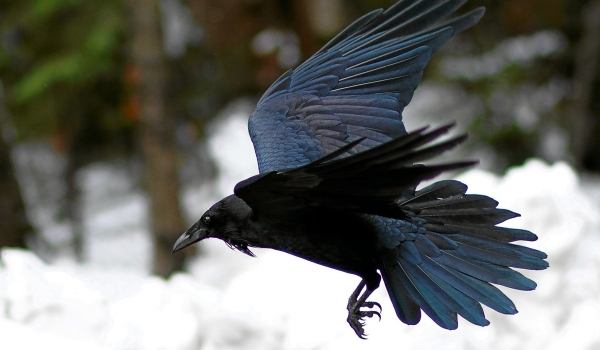
Photo: Raven in flight
The raven is one of the smartest living creatures on earth. It is noticed that before doing something, the raven quite accurately assesses the situation. And it works as useful as possible, excluding unnecessary movements. Scientists have repeatedly studied the mental abilities of birds. Experiments on intelligence led them to the conclusion that the raven has intelligence. It turned out that the bird quickly orients itself in the proposed complicated situation. An experiment conducted by ornithologists is well described.
The essence of the experience was as follows. The crow was offered a rather narrow transparent vessel with water, where a delicacy in the form of worms floated. Stone pebbles were laid out nearby. The raven, which could not reach the worm, quickly realized that it was possible to throw pebbles into the water, thereby raising the water level. In addition to stones, there were other objects in the pile that did not sink in water.
The raven thought of pulling them back so that they would not interfere. Thus, the bird quickly got to the delicacy. For the purity of the experiment, this experiment was repeated, and with other crows the result was the same. It has been noticed that the raven often uses improvised objects in order to get food.
The ability to wield auxiliary means is transmitted to young crows in the process of observing adults, so it cannot be called innate. The way the raven drinks also confirms his high intelligence. If most birds take water in their beaks and then raise their heads to make it glass, then the raven does otherwise. He puts his open beak on the water, turning his head to one side, as a result, the water itself flows into the cavity, he can only swallow it.
Despite the outwardly serious look, the raven is a very playful bird. Young crows are very willing to play with various objects, hiding them after playing enough. Moreover, they can involve other animals as an object for their fun, while observing the necessary caution.
Social structure and reproduction
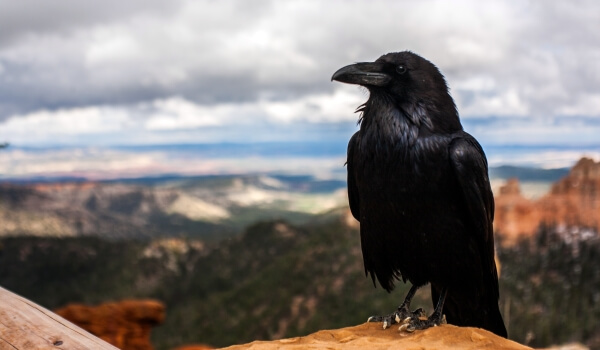
Photo: Raven bird
In its natural habitat, the raven is very faithful to its mate. In the second year of life, the raven reaches sexual maturity. Created couples maintain relationships for a long time. The mating season of ravens begins in winter in February. Mating is preceded by long flights over the object of one’s desire. At the same time, crows do not just fly, but perform various complex aerobatics, demonstrating their abilities. Both partners participate in the construction of the nest, they build a dwelling, usually on a tall tree in a dense crown.
So — or in other places inaccessible to enemies. The frame of the nest is made up of thicker branches that are intertwined. Large holes are braided with thinner branches, often clay is used as a building material. From the inside, a litter is equipped, which simultaneously serves as a heater. As a heater, any material suitable for this is used. It was noted that when choosing a litter, the crow takes into account the climatic features of the area. A crow’s nest can be over one meter in diameter.
March is the time for laying eggs. The female crow lays from 2-6 eggs of a grayish-blue color with brown patches. The incubation period lasts from 20-23 days, and both partners often participate in this. The chicks that have appeared have an excellent appetite, both spouses also have to feed, but usually the male does this. When the chicks hatch, the weather, especially at night, is very cool. The female crow practically does not leave her chicks for the first few days, continuing to warm them.
About 10 days after birth, young crows begin to learn to fly. First, flying to a neighboring branch, and at about 40 days of age, they already confidently take to the wing. Until the winter, they continue to live with their parents, adopting survival skills.
Interesting fact: Raven is very loyal to his brood. There are cases when even a wounded raven continued to hatch its offspring.
Natural enemies of ravens
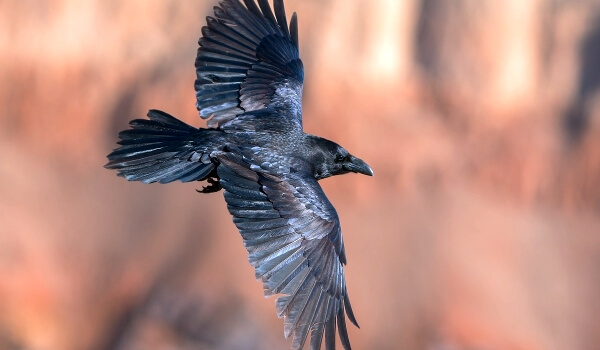
Photo: Raven animal
The raven is a large and strong bird, but it still has enough natural enemies in nature. The main enemies of the raven in the natural environment are large birds of prey such as eagles and hawks. In addition to them, owls are a serious danger. It is a nocturnal silent predator attacking nests while the birds are sleeping. What is a serious danger to the brood, and often to an adult bird. Among the ground threats are foxes, wolves, hyenas, jackals, predators of the marten order.
The raven, in search of carrion, has to coexist with these predators, and if he loses attention, he himself can become their prey. As for the threats to the crow in the city, there are much fewer of them than in the wild. In an urban environment, the constant proximity of a person somewhat dulls the raven’s caution to surrounding dangers. Stray dogs and even cats can take advantage of this factor. But such cases are quite rare, and this is another possible reason for the migration of ravens to the city limits. The main enemy for the raven at a certain period of history was man.
Interesting fact: It has been noticed that ravens throughout their lives often continue to communicate with close relatives, flying to visit each other.
Population and species status
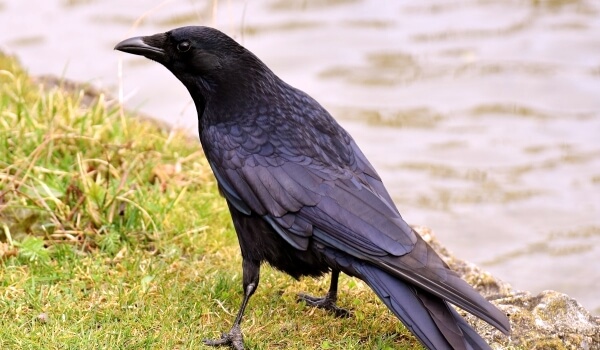
Photo: Raven bird
In the old days, especially in the 19th century, the raven was persecuted by humans. He was considered a symbol of misfortune and a harbinger of troubles, in addition to this, the raven was accused of destroying crops. All this led to the fact that they began to actively destroy the bird, including with the help of poisons. This caused a sharp decline in the population. Later, some European countries began to correct the situation by taking the raven under protection. Such measures bore fruit, and the number of crows began to increase.
An obstacle to the increase in the crow population in some regions is difficult winter conditions, which make it difficult to forage. Assimilation by man of new territories, then leads to an increase in the population of the crow in this region. The explanation is simple: where there is a person, there will always be food waste. The classic black raven is widely known to all inhabitants of the European part. But the detachment of ravens is quite numerous and is not limited only to this species.
Depending on the geographical location, the following types of ravens are known:
- Antilsk raven;
- New Koledonian raven;
- White-billed raven;
- Grey raven;
- American raven;
- Piebald raven;
- Brilliant raven;
- Flores raven;
- Cuban raven;
- Cape raven;
- Giant raven;
- Pygmy raven raven;
- Bismarck Raven;
- Jamaican Raven;
- Guam Raven;
- Desert Raven;
- Trumpeted Raven;
- Palm crow.
Some of the above species of crows are distributed in a rather limited area and their populations are rather small. Others live more widely, but more often within the same continent. The classic black raven, the most adaptable to any habitat, thanks to which we know it for what it is.
Crow Guard
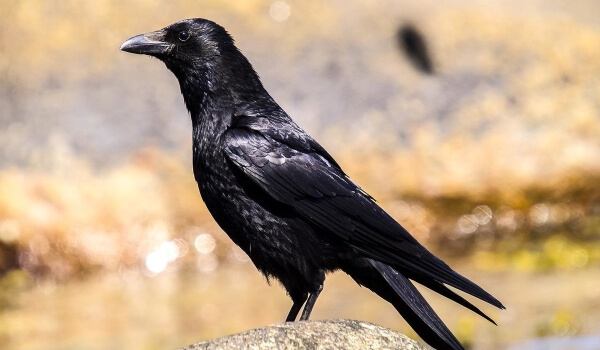
Photo: Raven Red Book
To suggest that the raven is a rare and endangered bird species is quite difficult for some. On the territory of the Russian Federation, at this time, the common crow as a species is not threatened with extinction. Which cannot be said with certainty for some Western European countries.
In some countries, including Germany, the raven is under state protection and is listed in the local Red Book. Once upon a time there were plenty of ravens. But “thanks” to much of church politics based on superstition, the crow began to be actively destroyed. This led to the fact that most of the population of ravens in Western Europe was destroyed.
In the second half of the last century, ravens were taken under active protection. In the German Alps there are ornithological stations where the migration of ravens is monitored by ringing. For a more detailed study of the behavior of these extraordinary birds, some individuals are specially kept in spacious enclosures.
The data obtained help in the work on maintaining and increasing the population of the crow in the natural environment. The way the Germans relate to wildlife, using the example of a bird that is not the rarest on earth, deserves all respect. All these measures are bearing fruit, and the number of crows there is gradually increasing.
We often do not notice those who surround our lives. The raven is an amazing bird, watching which can bring a lot of positive emotions and discoveries. A bird that rightfully occupies the intellectual peak among birds. To understand this, it is enough to put aside your affairs and watch her. And it is possible that the raven will teach us something new. For example, enjoy the simple things in life.

